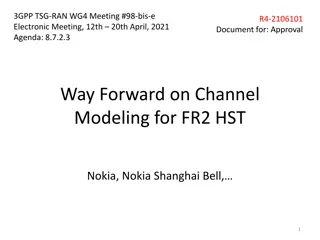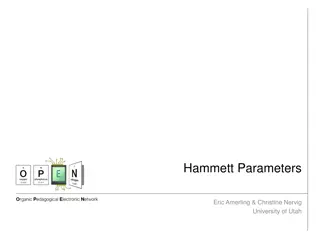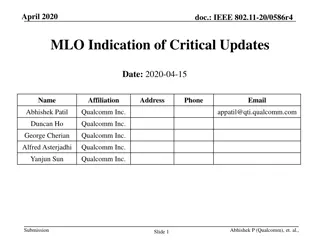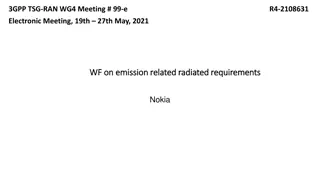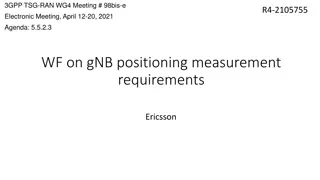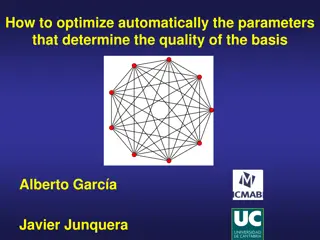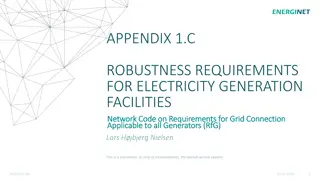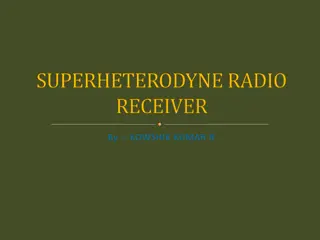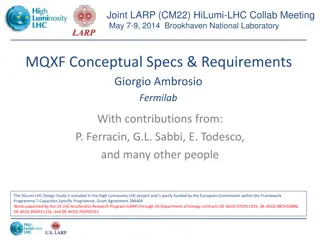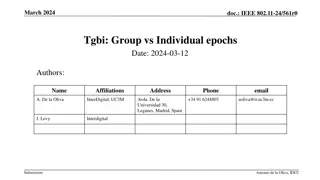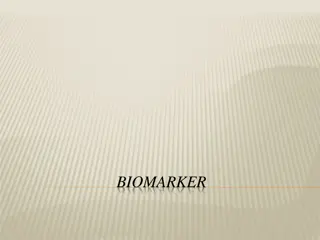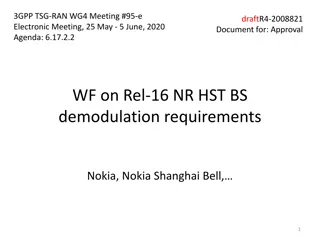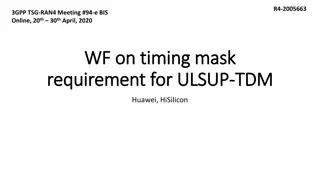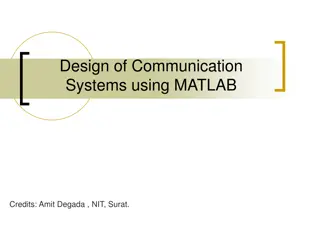PDSCH Demodulation Parameters & Requirements Discussion
This document covers the discussion on PDSCH demodulation parameters and requirements for UE demodulation and CSI reporting in FR2 DL 256QAM, specifically focusing on static channel mode, TDL-D channel mode, and TDL-A channel mode. The document also explores rank options, channel bandwidth, PRB allocation, propagation conditions, MCS configurations, MIMO configurations, and other related parameters for different scenarios. Various companies' perspectives and simulation results are considered for defining requirements.
Download Presentation

Please find below an Image/Link to download the presentation.
The content on the website is provided AS IS for your information and personal use only. It may not be sold, licensed, or shared on other websites without obtaining consent from the author.If you encounter any issues during the download, it is possible that the publisher has removed the file from their server.
You are allowed to download the files provided on this website for personal or commercial use, subject to the condition that they are used lawfully. All files are the property of their respective owners.
The content on the website is provided AS IS for your information and personal use only. It may not be sold, licensed, or shared on other websites without obtaining consent from the author.
E N D
Presentation Transcript
3GPP TSG-RAN4 Meeting #95e Electronic Meeting, 25 May - 5 June, 2020 Agenda item: 6.12.4 R4-2008817 Approval Document for: WF on UE demodulation and CSI reporting requirements for FR2 DL 256QAM China Telecom
Background: WF in previous meeting RAN4 #94e-Bis WF: R4-2005531
PDSCH Demodulation: Main Parameters Tx EVM 3% (CTC, Intel, Huawei, QC, DCM, Ericsson) Rx impairment modelling and band agnostic requirements The following scenarios can be considered for band agnostic requirements definition; and FFS for other scenarios Static channel mode: MCS 20-23, rank 1 TDL-D channel mode: MCS 20-21, rank 1 TDL-A channel mode: MCS 20-21, rank 1 FFS on whether to explicitly model Rx impairment until the next meeting Rank Option 1: Rank 1 (Huawei, QC, Ericsson, CTC, Intel) Option 2: Define requirements for Rank 1, FFS on whether to define requirements for rank 2 (CTC, DCM) Option 3: Define requirements for single Rank configuration, i.e., either rank1 or rank 2 (Intel)
PDSCH Demodulation: Main Parameters contd Channel bandwidth and PRB allocation Option 1: 100MHz CBW with full PRB allocation (Ericsson) Option 2: 100MHz CBW with partial PRB allocation Option 3: 50MHz CBW with full PRB allocation (Intel, Huawei, CTC, DCM) Propagation condition Option 1: Fading channel (QC, CTC, DCM, Ericsson) Option 1A: TDLA30-300 Option 1B: TDLD30-75 Option 1C: TDLD30-35 Option 2: Static channel (Intel) TBD in the next meeting based on more companies simulation results.
PDSCH Demodulation: Main Parameters contd MCS MCS 20 for rank 1, if requirements for rank 1 are to be defined. FFS for rank 2 MIMO configuration Option 1: 2Tx 2Rx ULA low (Ericsson) Option 2: 1Tx 2Rx Option 3: Depend on the agreement on propagation condition. Use 2Tx 2Rx ULA low if it is agreed to use fading channel, and use 1Tx 2Rx if it is agreed to use static channel. (Intel, QC, CTC, DCM, Huawei)
PDSCH Demodulation: Other Parameters DM-RS configuration Type 1 single symbol front loaded, 1 additional DMRS (CTC, Intel, Huawei, QC, Ericsson) PRB bundling size and Precoding model Option 1: PRB bundling size: 2 Precoding model: Random Precoding, per slot , WB granularity Depend on the agreement on propagation condition. Use option 1 if it is agreed to use fading channel; and TBD if it is agreed to use static channel (QC, CTC, Huawei, [E///]) HARQ process number 8 (Huawei, QC, CTC, DCM, Ericsson)
Agreed simulation parameters in previous meeting Parameter Unit kHz Value 120 SCS per 2PRB in frequency domain per symbol in time domain PT-RS configuration Overhead for TBS determination 6 PDSCH mapping type Type A TDD Configuration: DDDSU, S=10D:2G:2U PDCCH duration Symbol #0 in each slot Full DL slots: Start symbol 1, Duration 13 Special slots: Start symbol 1, Duration 9 Periodicity 20 ms, Allocated in first slot within 20ms 20 ms periodicity, 2 slots, Offset 10 ms PDSCH configuration SSB configuration TRS configuration HARQ RV sequence {0, 2, 3, 1} Receiver assumption MMSE-IRC Test metric 70% of max TP
SDR Requirements In the next meeting, decide whether to define SDR requirements for FR2 256QAM, based on more simulation results and analysis for testable SNR If it is agreed to define SDR requirements, consider the following test parameters: MCS and rank Option 1: Add MCS indexes 26, 21, 20 and 11 in MCS table 2 for both 1 and 2 MIMO layers. Run simulations for MCS 20 to MCS 26 in MCS table 2 to derive the required SNR achieving 85% of peak throughput under AWGN conditions. (China Telecom) Other options are not precluded.
CQI reporting Requirements In the next meeting, decide whether to define FR2 CQI reporting requirements for CQI table 2 If it is agreed to define FR2 CQI reporting, consider the following test parameters: Propagation condition Option 1: Cover both AWGN and fading conditions Other options are not precluded SNR testing point Option 1: Cover higher SNR testing point compared to that in Rel-15 FR2 CQI tests Other options are not precluded Other parameters Option 1: Reuse the assumptions in Rel-15 FR2 CQI tests Other options are not precluded




